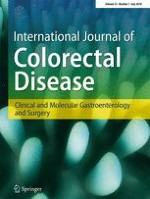Erschienen in:

07.05.2018 | Original Article
Risk factors for early postoperative complications and length of hospital stay in ileocecal resection and right hemicolectomy for Crohn’s disease: a single-center experience
verfasst von:
Christian Galata, Christel Weiss, Julia Hardt, Steffen Seyfried, Stefan Post, Peter Kienle, Karoline Horisberger
Erschienen in:
International Journal of Colorectal Disease
|
Ausgabe 7/2018
Einloggen, um Zugang zu erhalten
Abstract
Purpose
To determine risk factors for early postoperative complications and longer hospital stay after ileocecal resection and right hemicolectomy in a single-center cohort of patients with Crohn’s disease (CD).
Methods
A retrospective analysis of the prospectively maintained surgical database for patients with CD at our institution was performed. All consecutive patients operated on between January 2010 and December 2016 were included.
Results
A total of 305 patients were included. Median length of hospital stay was 7 days (interquartile range, IQR 6–10). Major postoperative complications were observed in 9.5% of patients (n = 29). Anastomotic leak was observed in five patients (1.8% of all patients with anastomosis). The rate of local septic complications was 4.3% (n = 13, anastomotic leak, postoperative abscess, and/or postoperative fistula). In multivariable analysis, independent risk factors for major postoperative complications were bowel perforation (odds ratio (OR) = 12.796, 95% CI = 1.144–143.178); elevated preoperative leucocyte levels (OR = 1.115, 95% CI = 1.013–1.228); and low levels of preoperative albumin (OR = 0.885, 95% CI = 0.827–0.948). The cutoff value for albumin was 32.5 g/L (sensitivity 75.9%, specificity 62.6%).
Conclusions
In this large cohort of patients surgically treated for CD in a tertiary referral center, 9.5% of the patients developed major postoperative complications. Preoperative albumin levels > 32.5 g/L significantly reduce the risk for postoperative complications and shorten the length of hospital stay. In a multidisciplinary concept with adequate preoperative management, surgery can be performed with a low rate of major complications and a very low rate of anastomotic leakage.











